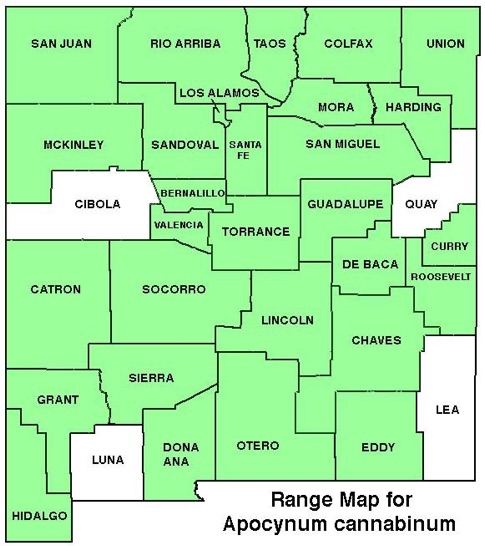WILDFLOWERS OF NEW MEXICO

Stems are erect, branching, reddish-brown, tough-fibrous. Plants reach 1–5 feet tall with shiny, oval, light-green leaves and clusters of small white flowers. Note the slightly spreading petals on the fragrant, white, bell-shaped flowers, ascending (not drooping) leaves, and milky sap. The flowers are magnets for bees, butterflies, flies, and beetles.
FLOWER: May–September. Loose clusters grow from branch tips and leaf axils; white to greenish flowers are bell shaped with 5 erect to slightly spreading petals, each 1/8 inch long (3 mm). Fruit is a 4–8 inch long (1–40 cm) slender, cylindrical pod.
LEAVES: Opposite, spreading to ascending. Blades oval to elliptic, 2–4 1/2 inches long (5–11.4 cm), top surface smooth, edges smooth, tip with a spiny point, veins prominent.
HABITAT: Gravelly, sandy soils, riparian areas, forest openings, roadsides, disturbed areas: cottonwood-willow, pinyon–juniper woodlands.
ELEVATION: 3,500–7,500 feet.
RANGE: Widespread in every state; Canada.
SIMILAR SPECIES: Spreading Dogbane, A. androsaemifolium, has flowers with white, pink-striped petals that curl backwards, drooping (not ascending) leaves, and occurs at mid- to high elevations.
NM COUNTIES: Widespread and common in NM foothills in mid-elevation habitats: nearly statewide (not reported in Cibola, Lea, Luna, Quay cos.)

INDIAN HEMP, COMMON DOGBANE
APOCYNUM CANNABINUM
Dogbane Family, Apocynaceae
Perennial herb


THE CONTENTS OF THIS WEBSITE ARE COPYRIGHTED AND CANNOT BE USED
WITHOUT PERMISSION OF GEORGE OXFORD MILLER
EMAIL ME




Leaves are opposite and ascending (angled upward).
Plants have bushy limbs and spread to form dense stands.
